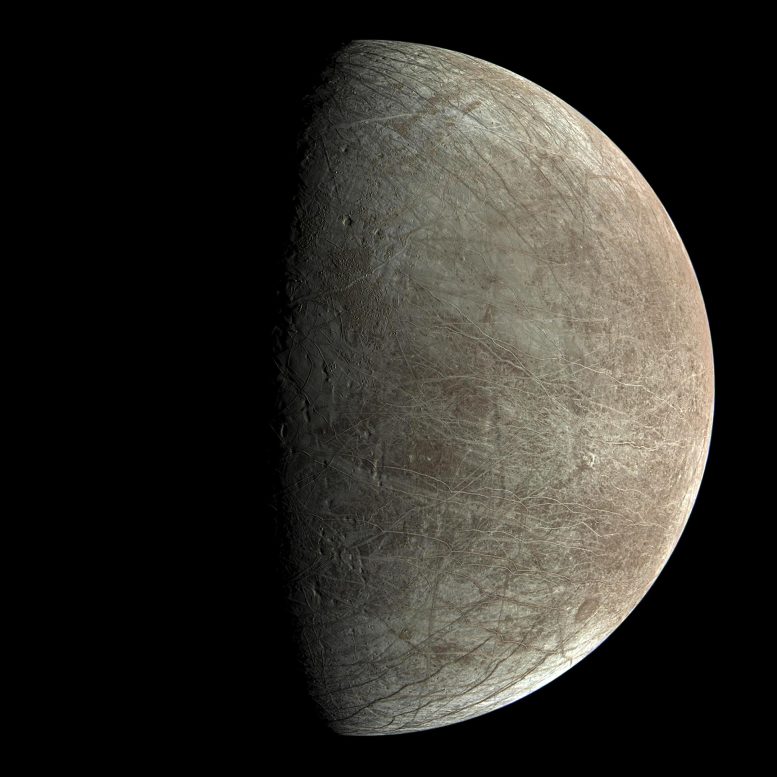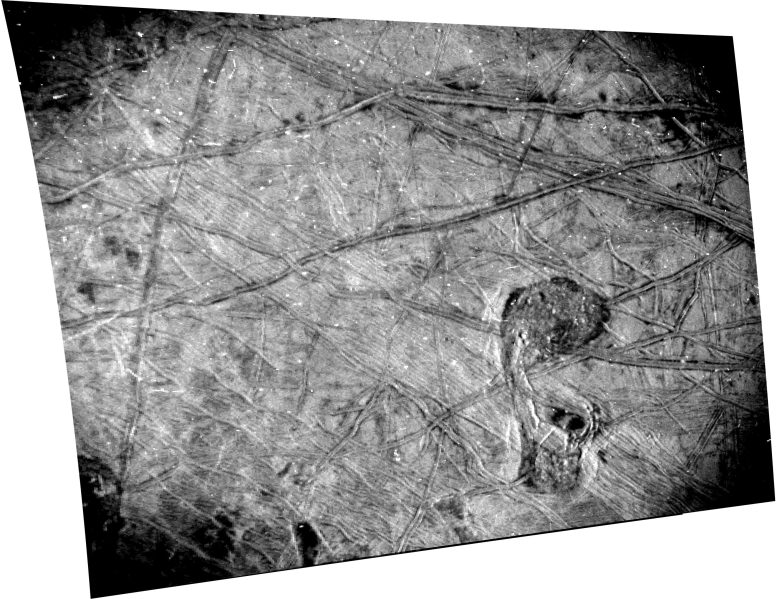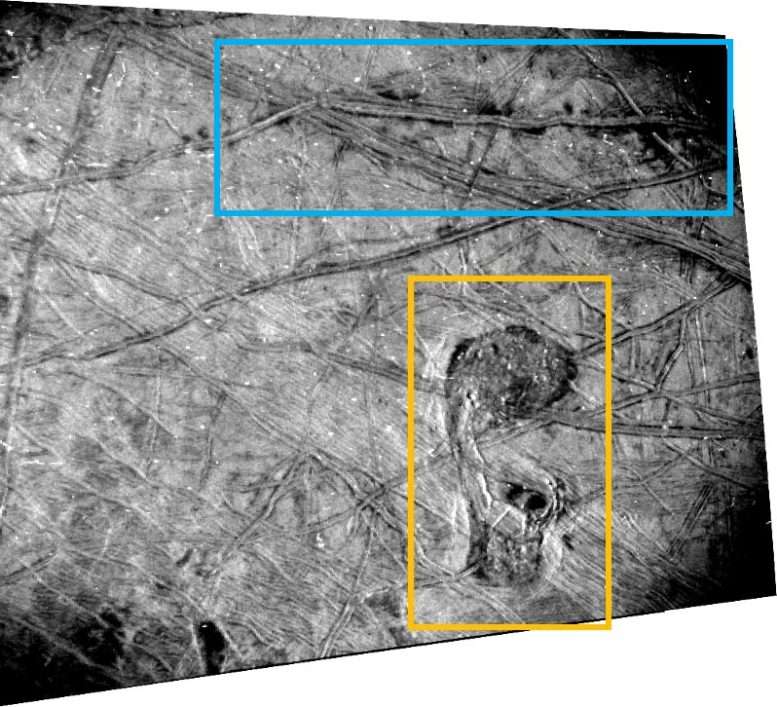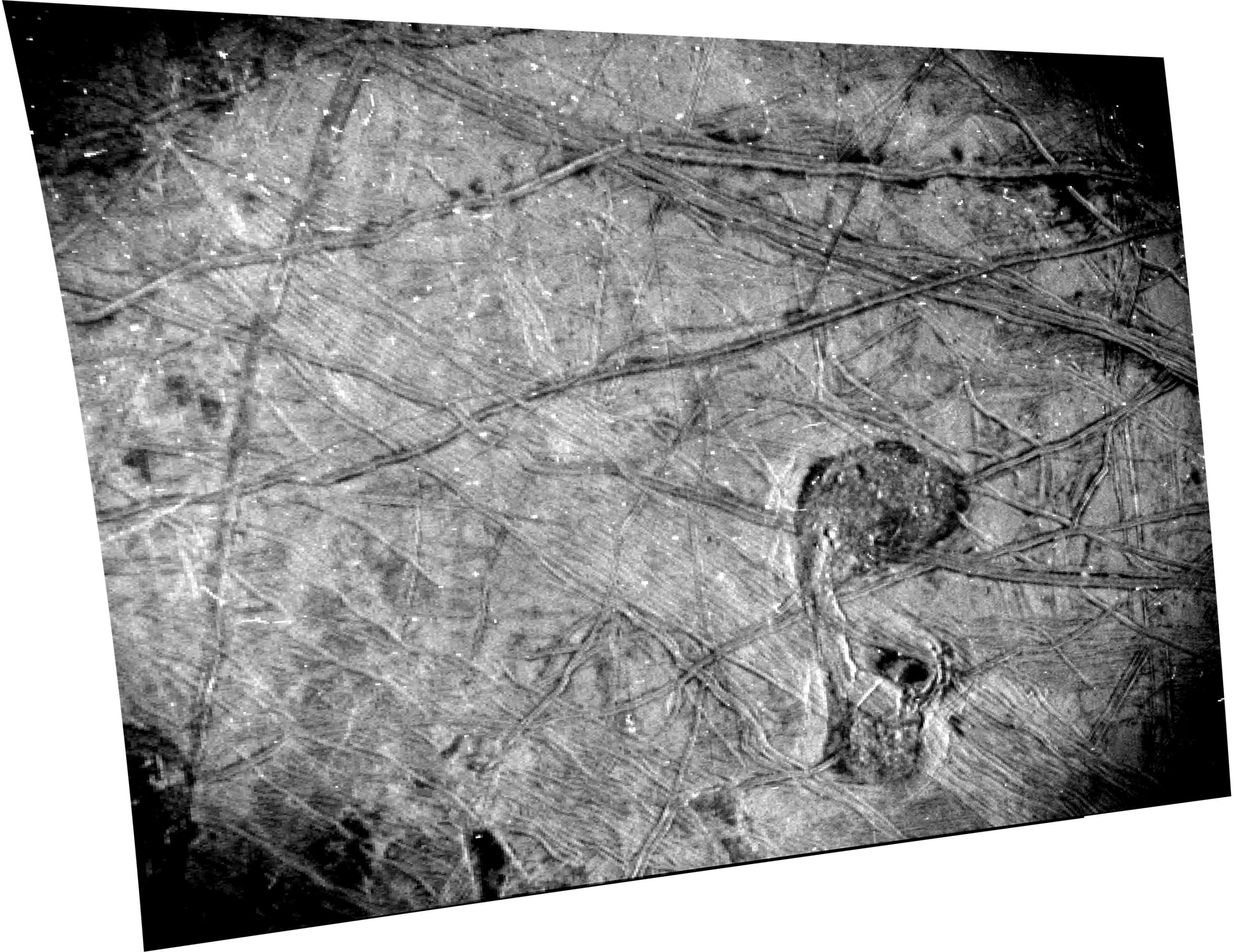
Jupiter’s moon Europa was captured by the JunoCam instrument aboard NASA’s Juno spacecraft during the mission’s close flyby on September 29, 2022. The images show cracks, ridges and bands crisscrossing the moon’s surface. Image credit: NASA/JPL-Caltech/SwRI/MSSS, Björn Johnson (CC BY 3.0)
NASAJuno has provided images that support the theory of true polar wandering over Europa, showing that the moon’s icy crust has moved. Images from the solar-powered spacecraft have revealed interesting features on the ice-covered Jovian moon, including geological disturbances and possible plume activity, indicating liquid water and brine reaching the surface.
Images taken by the JunoCam visible light camera aboard NASA’s Juno spacecraft support the theory that the ice crust at the North and South Poles is JupiterEuropa’s moon is not where it used to be. In addition, a high-resolution image from the spacecraft’s Stellar Reference Unit (SRU) shows indications of possible plume activity and disturbances in the icy crust, indicating that the brine may have recently floated to the surface.
JunoCam results were recently published in Planetary Science Journal The SRU results were published in the journal JGR Planets.
On September 29, 2022, Juno made its closest flyby of Europa, coming within 220 miles (355 kilometers) of the moon’s frozen surface. The four images taken by JunoCam and one by SRU are the first high-resolution images of Europa since Galileo’s last flyby in 2000.
True polar wandering
Juno’s ground path over Europa allowed it to photograph near the Moon’s equator. Analyzing the data, the JunoCam team found that besides the expected glaciers, walls, slopes, ridges and basins, the camera also captured steep, irregularly distributed depressions 12 to 31 miles (20 to 50 kilometers) wide. They resemble large oval craters previously found in images from other sites in Europe.
A giant ocean is thought to lie beneath Europa’s icy exterior, and these surface features have been linked to “Real polar wandering“, a theory that Europa’s outer icy crust is essentially floating and moving freely.

This black-and-white image of Europa’s surface was captured by the Stellar Reference Unit (SRU) aboard NASA’s Juno spacecraft during the flyby on September 29, 2022. The chaos feature nicknamed the “platypus” is visible in the lower right corner. Image source: NASA/JPL-Caltech/SwRI
“True polar wandering would occur if Europa’s icy crust separated from its rocky interior, creating high stress levels on the crust, leading to predictable fracture patterns,” says Candy Hansen, a Juno co-investigator who leads planning for JunoCam at the Planetary Center. Science Institute in Tucson, Arizona. “This is the first time these faulting patterns have been mapped in the Southern Hemisphere, suggesting that the impact of true polar wandering on Europa’s surface geology is more extensive than previously identified.”
High-resolution JunoCam images were also used to reclassify a previously prominent surface feature from the map of Europe.
“Crater Gwern no longer exists,” Hansen said. “What was previously thought to be a 13-mile-wide impact crater – one of the few documented impact craters in Europe – Gwern was revealed in JunoCam data as a set of intersecting ridges that created an elliptical shadow.”

This annotated image of Europa’s surface from Juno’s SRU shows the location of a double ridge running east-west (blue box) with possible plume patches and a chaotic feature the team calls the “platypus” (orange box). These features indicate current surface activity and the presence of subsurface liquid water on Jupiter’s icy moon. Image source: NASA/JPL-Caltech/SwRI
Platypus
Although all five images of Europa from Juno are high resolution, the image from the spacecraft’s black-and-white SRU provides the most detail. The SRU is designed to detect faint stars for navigation purposes, and is sensitive to low light. To avoid excessive lighting in the image, the team used the camera to capture the night side of Europa while it was illuminated only by scattered sunlight off Jupiter (a phenomenon called “Jupiter luminescence”).
This innovative imaging approach allowed complex surface features to be highlighted, revealing complex networks of intersecting ridges and dark spots created by potential water vapor plumes. One interesting feature, which covers an area of 23 miles by 42 miles (37 kilometers by 67 kilometers), was nicknamed the “platypus” by the team because of its shape.
Characterized by chaotic terrain with hummocks, prominent ridges, and dark reddish-brown material, the platypus is the smallest feature in its vicinity. Its northern “trunk” and southern “beak”—connected by a broken “neck” formation—cut the terrain surrounding a conglomerate matrix containing numerous ice masses ranging from 0.6 to 4.3 miles (1 to 7 km) wide. Ridge formations collapse into the feature at the edges of the platypus.
For the Juno team, these formations support the idea that Europa’s icy crust may give way in locations where pockets of salty water from the subsurface ocean exist below the surface.
About 31 miles (50 kilometers) north of the platypus, there is a group of twin hills surrounded by dark spots similar to features found elsewhere on Europe that scientists have hypothesized to be cryovolcanic plume deposits.
“These features indicate current surface activity and the presence of subsurface liquid water on Europa,” said Heidi Becker, principal investigator of the SRU at NASA’s Jet Propulsion Laboratory in Southern California, who also manages the mission. “The SRU image is a high-quality baseline for specific places on NASA and the European Space Agency’s (ESA) Europa Clipper mission.European Space Agency‘S ) juice quests can be targeted looking for signs of change and brine.
Europa Clipper’s focus is on Europa, including checking whether the icy moon could have conditions suitable for life. It is scheduled to launch in the fall of 2024 and arrive at Jupiter in 2030. Jupiter (Jupiter’s Icy Moons Explorer) was launched on April 14, 2023. The European Space Agency’s mission will arrive at Jupiter in July 2031 to study several targets (Jupiter’s three large icy moons ). , as well as fiery Io and smaller moons, as well as the planet’s atmosphere, magnetosphere, and rings) with a particular focus on Ganymede.
Juno performed its 61st close flyby of Jupiter on May 12. Its 62nd flyby of the gas giant, scheduled for June 13, includes a flyby of Io at an altitude of about 18,200 miles (29,300 kilometers).
References:
“Juno’s JunoCam images of Europe” by CJ Hansen, MA Ravine, PM Schenk, GC Collins, EJ Leonard, CB Phillips, MA Caplinger, F. Tosi, SJ Bolton and Björn Jónsson, 21 March 2024, Planetary Science Journal.
doi: 10.3847/PSJ/ad24f4
Reference: “A complex region of Europa’s surface with hints of recent activity revealed by the Juno stellar reference unit” by Heidi N. Baker, and Jonathan I. Lunin, and Paul M. Schenk, and Megan M. Florence, and Martin J. Brennan, and Candace J. Hansen, Yasmina M. Martos, Scott J. Bolton and James W. Alexander, December 22, 2023, Journal of Geophysical Research: Planets.
doi: 10.1029/2023JE008105
Jet Propulsion Laboratory, a division of the California Institute of Technology in Pasadena, California, manages the Juno mission for principal investigator Scott Bolton, of the Southwest Research Institute in San Antonio. Juno is part of NASA’s New Frontiers Program, which is managed at NASA’s Marshall Space Flight Center in Huntsville, Alabama, for the agency’s Science Mission Directorate in Washington. The Italian Space Agency (ASI) funded the Jovian InfraRed Auroral Mapper. Lockheed Martin Space in Denver built and operates the spacecraft.

“Typical beer advocate. Future teen idol. Unapologetic tv practitioner. Music trailblazer.”







More Stories
Boeing May Not Be Able to Operate Starliner Before Space Station Is Destroyed
How did black holes get so big and so fast? The answer lies in the darkness
UNC student to become youngest woman to cross space on Blue Origin